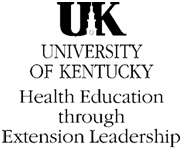The Physical Activity Team in the School of Human Environmental Sciences will be recognized at the 2009 KASEP annual meeting on March 18, as the Outstanding Project of 2009. Team members include Janet Kurzynske, Chair Nutrition and Food Sciences, Ingrid Adams and Kelley Weber also with NFS, Mark Purshwitz, Ag Engineering, Deborah Murray and Tyrone Atkinson, HEEL, Travonia Hughes, FCS Postdoctoral Fellow, and Diana Doggett, FCS Extension Agent.
The idea for the 2nd Sunday campaign emerged from the Built Environment Conference as a way for local communities to use existing community infrastructure to highlight the plight of physical activity as well as utilize one of the best community infrastructures, the road systems in every county. The concept of 2nd Sunday is for each community to close a highway, much the way they do with community parades, to encourage citizens to get out and walk, bike, skateboard, or other activities that can bring a community together for physical activity. The 2nd Sunday of October was chosen to bring the state together in a myriad of locally driven activities, planned and implemented at the grassroots level. The Physical Activity Committee served as facilitators and supporters of local efforts.
Governor Steve Beshear signed a proclamation designating 2nd Sunday in October for this purpose.
Tuesday, February 24, 2009
Wednesday, February 18, 2009
Harvard Offers Graduate Course on Learning to Walk???
Harvard Medical School's HEALTHBeat newsletter reports that although we learn to walk before age 2, most of us do not do it correctly. Walking correctly can prevent heal and knee injury. Although the US Department of Health and Human Services recommends vigorous walking for 21/2 hours a week, according to Harvard, there are no directions on how to walk. Harvard offers seven tips for walking correctly.
Tuesday, February 17, 2009
CDC Reports Data for Injuries and Deaths Among Children
The CDC has recently reported data regarding Kentucky's unintentional death and injury rates for children. The unintentional injury death rate was 23.1 per 100,000 population; this was higher than the national rate of 15.0 per 100,000 population. The unintentional injury death rate was 23.1 per 100,000 population; this was higher than the national rate of 15.0 per 100,000 population.
Kentucky averages 255 deaths of children 0 - 19 in a year's time. Transportation deaths and injuries lead the report at 14.7%.
Kentucky averages 255 deaths of children 0 - 19 in a year's time. Transportation deaths and injuries lead the report at 14.7%.
Friday, January 30, 2009
Kentucky Improves Health Ranking Among States
In 2008, Kentucky improved its health status ranking among the other 49 states by improving from 43rd to 37th in the state rankings, according to the United Health Foundation. However, the incidence of obesity since 1990 has increased 135%. Our percentage of Kentuckians without health insurance increased over 2007. Not surprising considering the economic climate.
Monday, January 26, 2009
Rise in Stress: Poor Health Habits
In the Boston Globe Sunday paper, an article reports on the consequences of the poor economy on health. Doctors and hospitals are reporting patients picking up bad habits they once had kicked, foregoing screening, and higher levels of stress. They are blaming it on the economy. Massachusetts health status in 2008 was third. Kentucky's health status improved from 43rd in 2007 to 37th in 2008. If Massachusetts is seeing this trend, what is the trend for Kentuckians?
Thursday, January 22, 2009
More Funding for SCHIP
The Los Angeles Times reported on the January passage by Congress of additonal funding for SCHIP to cover an additonal 4 million children in the United States. It is expected to be signed into law by President Obama. This surely will impact Kentucky, with 67,000 eligible kids who are not currently enrolled.
According to the Washington Post and Kaiser Health News, Americans are struggling even more to pay medical bills in this worsening economy. Many of these have insurance but struggle to pay
" fewer benefits, higher co-pays and additional deductibles -- and are at risk for large out-of-pocket bills when serious illness or injury strike. "
Submitted by Dr. Bob Flashman
According to the Washington Post and Kaiser Health News, Americans are struggling even more to pay medical bills in this worsening economy. Many of these have insurance but struggle to pay
" fewer benefits, higher co-pays and additional deductibles -- and are at risk for large out-of-pocket bills when serious illness or injury strike. "
Submitted by Dr. Bob Flashman
Friday, January 9, 2009
AMA Journal Reports Seniors Mixing OTC and Prescription Drugs
The New York Times reported on an American Medical Association journal that 1 in 25 seniors mixes over the counter drugs with prescription drugs and supplements and are at risk of suffering a bad reaction.
Subscribe to:
Posts (Atom)
